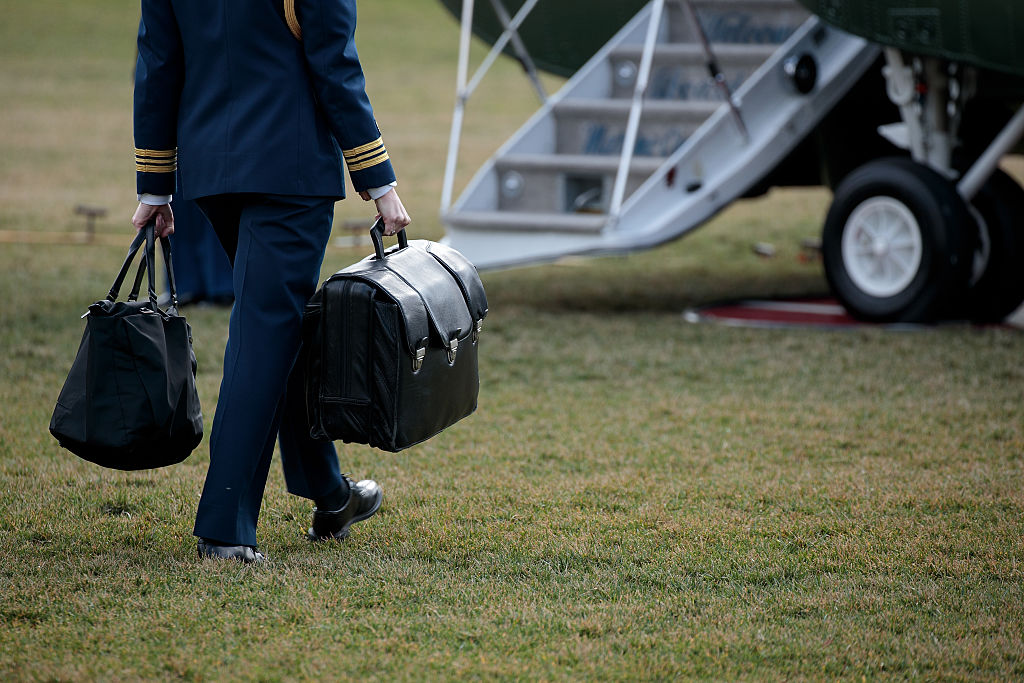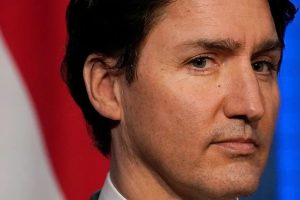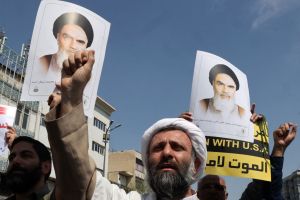Among the most alarming episodes during Donald J. Trump’s tumultuous final weeks in the White House was an announcement by the Speaker of the House of Representatives, Nancy Pelosi, on January 10:
‘This morning, I spoke to the Chairman of the Joint Chiefs of Staff [General] Mark Milley to discuss available precautions for preventing an unstable president from initiating military hostilities or accessing the launch codes and ordering a nuclear strike.’
Almost half a century earlier, there had been a similar — though secret — alarm about another unstable president with his finger on the nuclear button.
At the height of the Watergate Crisis in 1974, when President Richard Nixon, like Trump, was facing the threat of impeachment and (unlike Trump) was often drunk, defense secretary James Schlesinger secretly instructed the Pentagon that any nuclear strike ordered by Nixon must be personally approved by him. Chuck Hagel, who later served for two years as President Obama’s defense secretary, said recently: ‘I remember that episode very, very well. Scary stuff.’ Unlike Trump, however, Nixon resigned when threatened with impeachment and brought the crisis to an end.
The focus of the fears about both Nixon and Trump was presidential control of the doomsday nuclear ‘football’: a black, leather-covered attaché case, about forty pounds in weight, containing top secret instructions for launching nuclear weapons, carried by an aide known as the ‘bagman’ who is never far from the president’s side. The president himself has a laminated card (rather like a credit card) known as the ‘biscuit’ with a code which gives him access to the contents of the Football.
Once state-of-the-art, the football and the biscuit are now an antiquated and dangerously fallible system. Since the American atomic bomb was invented in 1945, political control of the decision to use nuclear weapons has never been properly thought through. So little thought was given to it by the wartime Franklin D. Roosevelt administration that Vice President Harry S. Truman was not even told the bomb was being constructed until he found himself in the Oval Office after Roosevelt’s sudden death in April 1945.
There is no written record of authorization by the new and inexperienced president for the bombing of Hiroshima and Nagasaki less than four months later. Truman’s decision a few weeks before Hiroshima to reveal to Stalin that ‘we had a new weapon of unusual destructive power’ was deeply ironic. Stalin seemed unimpressed by this top-secret news — as well he might, since, thanks to Soviet spies in the United States, he had known about American plans to build the atomic bomb for 15 times as long as Truman.
The football, devised during the early Cold War on President Eisenhower’s instructions, reflected the need to keep US nuclear forces on hair-trigger alert, given that there might be only half an hour’s warning of a sudden Soviet attack.
By far the most fraught handover of the football from one president to another followed the shooting of John F. Kennedy in Dallas on November 22, 1963. Kennedy’s vice-president and successor, Lyndon B. Johnson, had, inexplicably, refused to be briefed on the secrets of the football. With US forces on worldwide alert after the assassination, the United States thus had for a brief period a commander-in-chief who could not have responded to a Soviet missile attack. During the flight back from Dallas on Air Force One, Kennedy’s former military aide, Gen. Chester V. Clifton, explained to the new president the contents of the football. All subsequent vice-presidents, including Kamala Harris, have agreed to be ‘indoctrinated’ into the use of the football in case the president dies or is incapacitated.
Several presidents, however, have sometimes mislaid their biscuit. On one occasion, Jimmy Carter left his in the pocket of a jacket which the White House sent to the dry cleaners. After the assassination attempt on Ronald Reagan in March 1981, his biscuit disappeared while he was being operated on in Washington University Hospital. After a frantic search it was eventually discovered in a hospital plastic bag.
Mikhail Gorbachev’s last telephone call to President George H. W. Bush, on Christmas Day 1991 in the final days of the Soviet Union, was to reassure him that he had safely passed the Chemodanchik (the Russian football) to the Russian president Boris Yeltsin. When Yeltsin visited Washington in 1994, bringing the Chemodanchik with him (as Reagan had previously taken the football with him on a visit to Moscow), he privately suggested to Bush’s successor, Bill Clinton, that they devise a better and safer system.
Clinton gave the non-committal reply: ‘I’ll have to think about this.’ There’s little evidence that he did so. In 2000, according to the then-chairman of the Joint Chiefs of Staff, Gen. Hugh Shelton, Clinton lost his biscuit: ‘The codes were actually missing for months. This is a big deal, a gargantuan deal.’
There have also been unpublicized occasions when the president and the football have become separated. One former bagman who prefers not to reveal either his own identity or that of the president concerned, recalls an occasion when he was unable to follow the president into a crowded eighth-floor lift before it went down. He was forced to race down the service staircase ‘six steps at a time’ and managed to reach the ground floor just as the president emerged from the lift.
Soon after his inauguration four years ago, Trump said that being briefed on the nuclear football had been ‘very, very, very scary’:
‘When they explain what it represents and the kind of destruction that you’re talking about, it is a very sobering moment.’
An innovation of the Trump era was the appointment in 2020 of the first female bagman, Maj. Jayna McCarron. Her role was cut short last October when she contracted COVID-19, quite possibly from the President and his unmasked White House entourage. When Trump was flown to the Walter Reed National Military Medical Center, he was accompanied on the presidential helicopter Marine One by the nuclear football.
President-elect Joe Biden was first briefed on the football and the biscuit when he became Obama’s vice-president 12 years ago. In case the president is incapacitated, a bagman with an identical football follows the vice-president everywhere. Since Obama was almost 20 years younger than his vice-president, however, the prospect that Biden, rather than the president, would authorize nuclear retaliation, was always very slim
Though Vice President Biden (codenamed CELTIC after his partly Irish roots) got on well with the Secret Service detail responsible for his personal security, he disliked the presence of the bagman during his travels outside Washington. Anxious to preserve his image as ‘a regular Joe’ during weekly visits to his home in Wilmington, Delaware, he forbade the usual vice-presidential motorcade in which the bagman travelled in a limousine immediately behind his own.
In the new administration, Biden will no longer be able to keep the bagman at a distance when he is out of Washington. And, since he is the oldest elected president in US history and almost certainly will not serve a second term, Vice President Kamala Harris will have a far more important connection with the football than Biden in the Obama administration. Their first priority should be to rethink a system for authorizing the use of nuclear weapons which is no longer fit for purpose.
This article was originally published on The Spectator’s UK website.


















